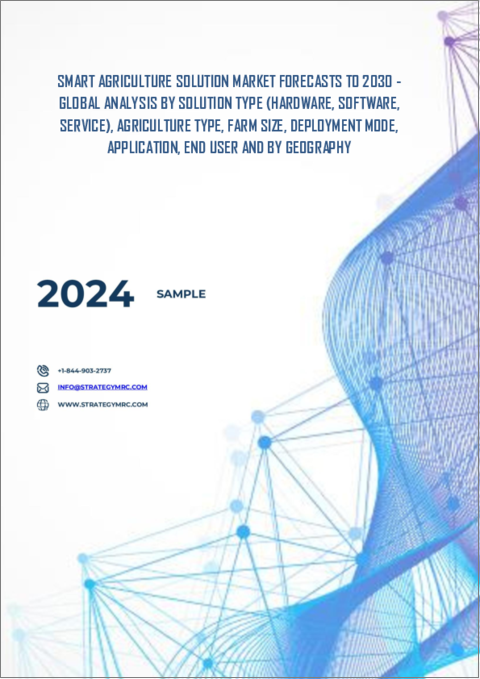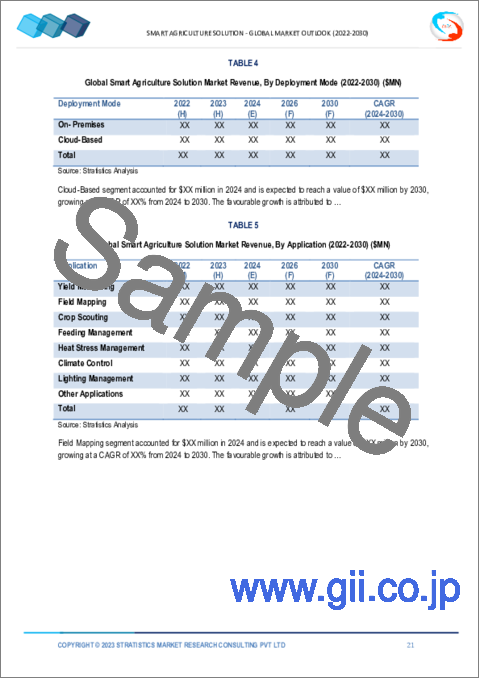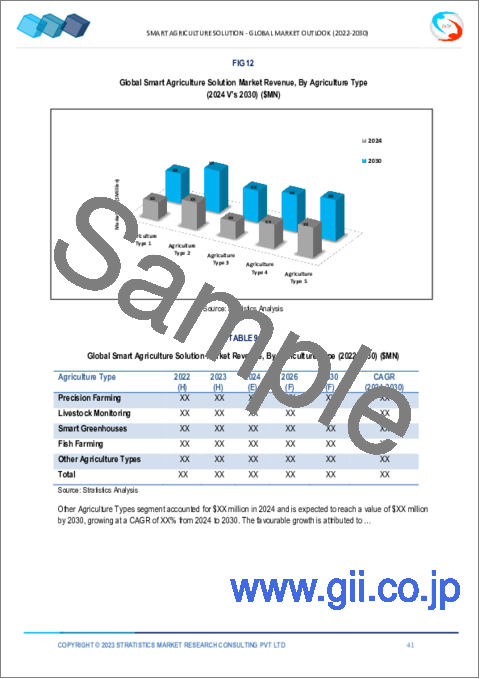|
|
市場調査レポート
商品コード
1530659
スマート農業ソリューション市場の2030年までの予測: ソリューションタイプ別、農業タイプ別、農場規模別、展開モード別、用途別、エンドユーザー別、地域別の世界分析Smart Agriculture Solution Market Forecasts to 2030 - Global Analysis By Solution Type (Hardware, Software, Service), Agriculture Type, Farm Size, Deployment Mode, Application, End User and By Geography |
||||||
カスタマイズ可能
|
|||||||
| スマート農業ソリューション市場の2030年までの予測: ソリューションタイプ別、農業タイプ別、農場規模別、展開モード別、用途別、エンドユーザー別、地域別の世界分析 |
|
出版日: 2024年08月01日
発行: Stratistics Market Research Consulting
ページ情報: 英文 200+ Pages
納期: 2~3営業日
|
- 全表示
- 概要
- 図表
- 目次
Stratistics MRCによると、スマート農業ソリューションの世界市場は2024年に156億米ドルを占め、予測期間中のCAGRは8.9%で成長し、2030年には261億米ドルに達する見込みです。
スマート農業ソリューションは、効率性、生産性、持続可能性を高めるために、従来の農業慣行にテクノロジーを統合するものです。これらのソリューションは、作物、土壌状態、家畜の健康状態、天候パターンを監視するためのIoTセンサー、ドローン、AI、データ分析などのさまざまな技術を包含しています。リアルタイムの洞察と自動化された意思決定機能を提供することで、スマート農業は資源配分を最適化し、環境への影響を低減し、作物の収量を向上させる。この変革的なアプローチは、農家が十分な情報に基づいた意思決定を行い、変化する農業条件に効果的に適応するのに役立ちます。
先端技術の採用増加
同市場では、リアルタイムのデータ収集のためのIoTセンサー、予測分析のためのAIアルゴリズム、精密農業のためのドローン技術などのイノベーションによって、先端技術の採用が急増しています。これらの技術により、農家は資源利用の最適化、作物の健康状態の遠隔監視、灌漑や害虫駆除などの作業の自動化が可能になります。スマートデバイスとクラウドプラットフォームの統合により意思決定が強化され、持続可能な実践が促進され、農業生産性が向上します。
データセキュリティへの懸念
IoTデバイスとクラウドベースのシステムが統合された結果、データ・セキュリティが業界の大きな問題となっています。問題には、センサー・ネットワークの脆弱性、農作物の収穫量や天候パターンなどの機密データを危険にさらすデータ侵害の可能性、強固な暗号化プロトコルの必要性などがあります。データの安全な伝送と保存を確保することは、不正アクセスやサイバー攻撃のリスクを軽減し、農家の業務上の見識を守り、高度な農業技術に対する信頼を維持するために極めて重要です。
食糧需要の増大
世界人口の増加と食糧需要の高まりが市場のイノベーションを促進しています。これらの技術は、IoT、AI、データ分析を活用して農業プロセスを最適化し、生産性を高め、持続可能な実践を保証します。主なソリューションには、精密農業、スマート灌漑システム、作物モニタリングツールなどがあり、農家がデータに基づいた意思決定を行い、資源を節約し、収量を増やすことを可能にします。このセクターの成長は、環境への影響を緩和しながら将来の食糧需要を効率的に満たすために極めて重要です。
技術的専門知識の不足
農家やその他のプレーヤーの技術的知識の不足は、市場における大きな問題です。先進技術を導入するには専門知識が必要です。このギャップが、スマート農法の導入や農業資源の効率的利用の妨げとなっています。この課題に対処するには、総合的なトレーニング・プログラムと、技術的な知識を持たないユーザーのニーズに合わせた使いやすいソリューションを提供し、農業におけるデジタル・リテラシーを高める支援的エコシステムを育成する必要があります。
COVID-19の影響:
COVID-19の大流行は、封鎖や社会的遠ざけ対策の中で農場を遠隔監視・管理する必要性に後押しされ、スマート農業ソリューションの採用を大幅に加速させました。IoTセンサー、AI主導の分析、精密農業ツールなどの技術は、生産性と効率を維持するために不可欠となった。農家が食糧安全保障を確保するために、弾力性のある技術対応アプローチを求めているため、市場ではデジタル農業ソリューションへの投資が増加しました。
予測期間中、家畜モニタリング分野が最大になる見込み
予測期間中、家畜モニタリングが最大となる見込みです。これらのシステムは、健康状態、場所、行動などの重要なパラメータをリアルタイムで追跡します。給餌パターンや健康指標に関するデータを活用することで、農家は繁殖サイクルを最適化し、病気を早期に発見し、全体的な管理効率を向上させることができます。このような技術革新は、より良い動物ケアを保証するだけでなく、資源の浪費を最小限に抑え、収穫量を最大化することで、持続可能な農業の実践にも貢献します。
予測期間中、給餌管理分野のCAGRが最も高くなると予想されます。
給餌管理分野は予測期間中CAGRが最も高くなると予想されます。AIアルゴリズムはこのデータを分析し、正確な給餌スケジュールと飼料調整を推奨し、動物の健康と生産性を向上させる。自動給餌器と精密給餌技術は、さらに資源利用の効率性を確保します。この総合的なアプローチは農場の収益性を向上させるだけでなく、廃棄物や環境への影響を削減することで持続可能な慣行を促進します。
最大のシェアを占める地域
予測期間中、北米が最大の市場シェアを占めると予測されます。農家はビッグデータ分析とAIを活用して、作付け、灌漑、害虫管理について情報に基づいた意思決定を行っています。水の使用量を削減し、環境への影響を最小限に抑え、土壌の健全性を向上させるスマートテクノロジーによって、持続可能な農法が重視されるようになっています。この市場は、農場規模の拡大、より高い生産性への需要、デジタル農業を支援する政府の取り組みによって成長を目の当たりにしています。
CAGRが最も高い地域:
予測期間中、アジア太平洋地域が最も高いCAGRを維持すると予測されます。化学薬品の使用量削減と土壌の健全性モニタリングが持続可能な農業を促進し、世界の環境目標に合致しています。接続性の向上とリアルタイムのデータにより、農家はより効率的に市場にアクセスできるようになり、より良い価格交渉と市場統合が促進されます。農業の急成長、自動化とスマート灌漑システムにより、資源利用が最適化され、環境への影響が最小限に抑えられます。
無料のカスタマイズサービス:
本レポートをご購読のお客様には、以下の無料カスタマイズオプションのいずれかをご利用いただけます:
- 企業プロファイル
- 追加市場プレイヤーの包括的プロファイリング(3社まで)
- 主要企業のSWOT分析(3社まで)
- 地域セグメンテーション
- 顧客の関心に応じた主要国の市場推計・予測・CAGR(注:フィージビリティチェックによる)
- 競合ベンチマーキング
- 製品ポートフォリオ、地理的プレゼンス、戦略的提携に基づく主要企業のベンチマーキング
目次
第1章 エグゼクティブサマリー
第2章 序文
- 概要
- ステークホルダー
- 調査範囲
- 研究調査手法
- データマイニング
- データ分析
- データ検証
- 調査アプローチ
- 調査情報源
- 1次調査情報源
- 2次調査情報源
- 前提条件
第3章 市場動向分析
- 促進要因
- 抑制要因
- 機会
- 脅威
- 用途分析
- エンドユーザー分析
- 新興市場
- COVID-19の影響
第4章 ポーターのファイブフォース分析
- 供給企業の交渉力
- 買い手の交渉力
- 代替品の脅威
- 新規参入業者の脅威
- 競争企業間の敵対関係
第5章 世界のスマート農業ソリューション市場:ソリューションタイプ別
- ハードウェア
- センサー
- ドローン
- ロボット
- GPSシステム
- ソフトウェア
- 農場管理ソフトウェア
- データ分析プラットフォーム
- クラウドベースのソリューション
- 予測分析ツール
- サービス
- コンサルティング
- マネージドサービス
- 統合サービス
第6章 世界のスマート農業ソリューション市場:農業タイプ別
- 精密農業
- 家畜モニタリング
- スマート温室
- 魚養殖
- その他の農業タイプ
第7章 世界のスマート農業ソリューション市場:農場規模別
- 小規模農場
- 中規模農場
- 大規模農場
第8章 世界のスマート農業ソリューション市場:展開モード別
- オンプレミス
- クラウドベース
第9章 世界のスマート農業ソリューション市場:用途別
- 収量モニタリング
- フィールドマッピング
- 作物調査
- 給餌管理
- 熱ストレス管理
- 気候制御
- 照明管理
- その他の用途
第10章 世界のスマート農業ソリューション市場:エンドユーザー別
- 農民
- 農業協同組合
- 農業関連産業
- 学術調査機関
- その他のエンドユーザー
第11章 世界のスマート農業ソリューション市場:地域別
- 北米
- 米国
- カナダ
- メキシコ
- 欧州
- ドイツ
- 英国
- イタリア
- フランス
- スペイン
- その他欧州
- アジア太平洋
- 日本
- 中国
- インド
- オーストラリア
- ニュージーランド
- 韓国
- その他アジア太平洋地域
- 南米
- アルゼンチン
- ブラジル
- チリ
- その他南米
- 中東・アフリカ
- サウジアラビア
- アラブ首長国連邦
- カタール
- 南アフリカ
- その他中東とアフリカ
第12章 主な発展
- 契約、パートナーシップ、コラボレーション、合弁事業
- 買収と合併
- 新製品発売
- 事業拡大
- その他の主要戦略
第13章 企業プロファイリング
- Deere & Company
- Trimble Inc.
- AGCO Corporation
- AG Leader Technology
- TeeJet Technologies
- Topcon Positioning Systems, Inc.
- Hexagon Agriculture
- Yara International ASA
- CropX Technologies Ltd.
- Kubota Corporation
- Prospera Technologies
- Granular, Inc.
- TopFlight Technologies
- Autonomous Tractor Corporation
- PrecisionHawk Inc.
- Mavrx Inc.
- Farmobile
List of Tables
- Table 1 Global Smart Agriculture Solution Market Outlook, By Region (2022-2030) ($MN)
- Table 2 Global Smart Agriculture Solution Market Outlook, By Solution Type (2022-2030) ($MN)
- Table 3 Global Smart Agriculture Solution Market Outlook, By Hardware (2022-2030) ($MN)
- Table 4 Global Smart Agriculture Solution Market Outlook, By Sensors (2022-2030) ($MN)
- Table 5 Global Smart Agriculture Solution Market Outlook, By Drones (2022-2030) ($MN)
- Table 6 Global Smart Agriculture Solution Market Outlook, By Robots (2022-2030) ($MN)
- Table 7 Global Smart Agriculture Solution Market Outlook, By GPS Systems (2022-2030) ($MN)
- Table 8 Global Smart Agriculture Solution Market Outlook, By Software (2022-2030) ($MN)
- Table 9 Global Smart Agriculture Solution Market Outlook, By Farm Management Software (2022-2030) ($MN)
- Table 10 Global Smart Agriculture Solution Market Outlook, By Data Analytics Platforms (2022-2030) ($MN)
- Table 11 Global Smart Agriculture Solution Market Outlook, By Cloud-Based Solutions (2022-2030) ($MN)
- Table 12 Global Smart Agriculture Solution Market Outlook, By Predictive Analytics Tools (2022-2030) ($MN)
- Table 13 Global Smart Agriculture Solution Market Outlook, By Service (2022-2030) ($MN)
- Table 14 Global Smart Agriculture Solution Market Outlook, By Consulting (2022-2030) ($MN)
- Table 15 Global Smart Agriculture Solution Market Outlook, By Managed Services (2022-2030) ($MN)
- Table 16 Global Smart Agriculture Solution Market Outlook, By Integration Services (2022-2030) ($MN)
- Table 17 Global Smart Agriculture Solution Market Outlook, By Agriculture Type (2022-2030) ($MN)
- Table 18 Global Smart Agriculture Solution Market Outlook, By Precision Farming (2022-2030) ($MN)
- Table 19 Global Smart Agriculture Solution Market Outlook, By Livestock Monitoring (2022-2030) ($MN)
- Table 20 Global Smart Agriculture Solution Market Outlook, By Smart Greenhouses (2022-2030) ($MN)
- Table 21 Global Smart Agriculture Solution Market Outlook, By Fish Farming (2022-2030) ($MN)
- Table 22 Global Smart Agriculture Solution Market Outlook, By Other Agriculture Types (2022-2030) ($MN)
- Table 23 Global Smart Agriculture Solution Market Outlook, By Farm Size (2022-2030) ($MN)
- Table 24 Global Smart Agriculture Solution Market Outlook, By Small Farms (2022-2030) ($MN)
- Table 25 Global Smart Agriculture Solution Market Outlook, By Medium Farms (2022-2030) ($MN)
- Table 26 Global Smart Agriculture Solution Market Outlook, By Large Farms (2022-2030) ($MN)
- Table 27 Global Smart Agriculture Solution Market Outlook, By Deployment Mode (2022-2030) ($MN)
- Table 28 Global Smart Agriculture Solution Market Outlook, By On-Premises (2022-2030) ($MN)
- Table 29 Global Smart Agriculture Solution Market Outlook, By Cloud-Based (2022-2030) ($MN)
- Table 30 Global Smart Agriculture Solution Market Outlook, By Application (2022-2030) ($MN)
- Table 31 Global Smart Agriculture Solution Market Outlook, By Yield Monitoring (2022-2030) ($MN)
- Table 32 Global Smart Agriculture Solution Market Outlook, By Field Mapping (2022-2030) ($MN)
- Table 33 Global Smart Agriculture Solution Market Outlook, By Crop Scouting (2022-2030) ($MN)
- Table 34 Global Smart Agriculture Solution Market Outlook, By Feeding Management (2022-2030) ($MN)
- Table 35 Global Smart Agriculture Solution Market Outlook, By Heat Stress Management (2022-2030) ($MN)
- Table 36 Global Smart Agriculture Solution Market Outlook, By Climate Control (2022-2030) ($MN)
- Table 37 Global Smart Agriculture Solution Market Outlook, By Lighting Management (2022-2030) ($MN)
- Table 38 Global Smart Agriculture Solution Market Outlook, By Other Applications (2022-2030) ($MN)
- Table 39 Global Smart Agriculture Solution Market Outlook, By End User (2022-2030) ($MN)
- Table 40 Global Smart Agriculture Solution Market Outlook, By Farmers (2022-2030) ($MN)
- Table 41 Global Smart Agriculture Solution Market Outlook, By Agricultural Cooperatives (2022-2030) ($MN)
- Table 42 Global Smart Agriculture Solution Market Outlook, By Agribusinesses (2022-2030) ($MN)
- Table 43 Global Smart Agriculture Solution Market Outlook, By Academic & Research Institutes (2022-2030) ($MN)
- Table 44 Global Smart Agriculture Solution Market Outlook, By Other End Users (2022-2030) ($MN)
Note: Tables for North America, Europe, APAC, South America, and Middle East & Africa Regions are also represented in the same manner as above.
According to Stratistics MRC, the Global Smart Agriculture Solution Market is accounted for $15.6 billion in 2024 and is expected to reach $26.1 billion by 2030 growing at a CAGR of 8.9% during the forecast period. Smart Agriculture Solutions integrate technology into traditional agricultural practices to enhance efficiency, productivity, and sustainability. These solutions encompass a range of technologies such as IoT sensors, drones, AI, and data analytics to monitor crops, soil conditions, livestock health, and weather patterns. By providing real-time insights and automated decision-making capabilities, smart agriculture optimizes resource allocation, reduces environmental impact, and improves crop yields. This transformative approach helps farmers make informed decisions and adapt to changing agricultural conditions more effectively.
Market Dynamics:
Driver:
Rising adoption of advanced technologies
The market is witnessing a surge in advanced technology adoption, driven by innovations such as IoT sensors for real-time data collection, AI algorithms for predictive analytics, and drone technology for precision farming. These technologies enable farmers to optimize resource usage, monitor crop health remotely, and automate tasks like irrigation and pest control. Integration of smart devices with cloud platforms enhances decision-making, fostering sustainable practices and improving agricultural productivity.
Restraint:
Data security concerns
Data security presents substantial industry issues as a result of the integration of IoT devices and cloud-based systems. Issues include vulnerabilities in sensor networks, potential data breaches compromising sensitive farm data (like crop yields and weather patterns), and the need for robust encryption protocols. Ensuring secure data transmission and storage is crucial to mitigate risks of unauthorized access and cyber-attacks, safeguarding farmers' operational insights and maintaining trust in advanced agricultural technologies.
Opportunity:
Growing demand for food
The increasing global population and rising food demand are driving innovations in the market. These technologies leverage IoT, AI, and data analytics to optimize farming processes, enhance productivity, and ensure sustainable practices. Key solutions include precision farming, smart irrigation systems, and crop monitoring tools, which enable farmers to make data-driven decisions, conserve resources, and increase yields. This sector's growth is crucial for meeting future food demands efficiently while mitigating environmental impact.
Threat:
Lack of technical expertise
The lack of technical knowledge among farmers and other players is a major problem in the market. Implementing advanced technologies requires specialized knowledge. This gap hinders the adoption of smart farming practices and efficient use of agricultural resources. Addressing this challenge involves providing comprehensive training programs and user-friendly solutions tailored to the needs of non-technical users, fostering a supportive ecosystem that enhances digital literacy in agriculture.
Covid-19 Impact:
The COVID-19 pandemic significantly accelerated the adoption of smart agriculture solutions, driven by the need for remote monitoring and management of farms amidst lockdowns and social distancing measures. Technologies like IoT sensors, AI-driven analytics, and precision agriculture tools became crucial for maintaining productivity and efficiency. The market saw increased investment in digital farming solutions as farmers sought resilient, technology-enabled approaches to ensure food security.
The livestock monitoring segment is expected to be the largest during the forecast period
The livestock monitoring is expected to be the largest during the forecast period. These systems track vital parameters like health status, location, and behavior in real-time. By leveraging data on feeding patterns and health indicators, farmers can optimize breeding cycles, detect illnesses early, and improve overall management efficiency. Such innovations not only ensure better animal care but also contribute to sustainable farming practices by minimizing resource wastage and maximizing yield.
The feeding management segment is expected to have the highest CAGR during the forecast period
The feeding management segment is expected to have the highest CAGR during the forecast period. AI algorithms analyze this data to recommend precise feeding schedules and dietary adjustments, enhancing animal health and productivity. Automated feeders and precision feeding techniques further ensure efficiency in resource utilization. This holistic approach not only improves farm profitability but also promotes sustainable practices by reducing waste and environmental impact.
Region with largest share:
North America is projected to hold the largest market share during the forecast period. Farmers are leveraging big data analytics and AI to make informed decisions about planting, irrigation and pest management. There's a growing emphasis on sustainable farming practices, driven by smart technologies that reduce water usage, minimize environmental impact, and improve soil health. The market is witnessing growth due to increasing farm sizes, demand for higher productivity, and government initiatives supporting digital agriculture.
Region with highest CAGR:
Asia Pacific is projected to hold the highest CAGR over the forecast period. Reduced chemical usage and soil health monitoring promote sustainable farming practices, aligning with global environmental goals. Improved connectivity and real-time data enable farmers to access markets more efficiently, facilitating better price negotiation and market integration. Rapid growth in agriculture, automation and smart irrigation systems optimize resource utilization and minimize environmental impact.
Key players in the market
Some of the key players in Smart Agriculture Solution market include Deere & Company, Trimble Inc., AGCO Corporation, AG Leader Technology, TeeJet Technologies, Topcon Positioning Systems, Inc., Hexagon Agriculture, Yara International ASA, CropX Technologies Ltd., Kubota Corporation, Prospera Technologies, Granular, Inc., TopFlight Technologies, Autonomous Tractor Corporation, PrecisionHawk Inc., Mavrx Inc. and Farmobile.
Key Developments:
In July 2023, Deere & Company announced the acquisition of Smart Apply, Inc. The company planned to leverage Smart Apply's precision spraying to assist growers in addressing the challenges associated with input costs, labor, regulatory requirements, and environmental goals.
In April 2023, AGCO Corporation announced a strategic collaboration with Hexagon, for the expansion of AGCO's factory-fit and aftermarket guidance offerings. The new guidance system was planned to be commercialized as Fuse Guide on Valtra and Massey Ferguson tractors.
Solution Types Covered:
- Hardware
- Software
- Service
Agriculture Types Covered:
- Precision Farming
- Livestock Monitoring
- Smart Greenhouses
- Fish Farming
- Other Agriculture Types
Farm Sizes Covered:
- Small Farms
- Medium Farms
- Large Farms
Deployment Modes Covered:
- On-Premises
- Cloud-Based
Applications Covered:
- Yield Monitoring
- Field Mapping
- Crop Scouting
- Feeding Management
- Heat Stress Management
- Climate Control
- Lighting Management
- Other Applications
End Users Covered:
- Farmers
- Agricultural Cooperatives
- Agribusinesses
- Academic & Research Institutes
- Other End Users
Regions Covered:
- North America
- US
- Canada
- Mexico
- Europe
- Germany
- UK
- Italy
- France
- Spain
- Rest of Europe
- Asia Pacific
- Japan
- China
- India
- Australia
- New Zealand
- South Korea
- Rest of Asia Pacific
- South America
- Argentina
- Brazil
- Chile
- Rest of South America
- Middle East & Africa
- Saudi Arabia
- UAE
- Qatar
- South Africa
- Rest of Middle East & Africa
What our report offers:
- Market share assessments for the regional and country-level segments
- Strategic recommendations for the new entrants
- Covers Market data for the years 2022, 2023, 2024, 2026, and 2030
- Market Trends (Drivers, Constraints, Opportunities, Threats, Challenges, Investment Opportunities, and recommendations)
- Strategic recommendations in key business segments based on the market estimations
- Competitive landscaping mapping the key common trends
- Company profiling with detailed strategies, financials, and recent developments
- Supply chain trends mapping the latest technological advancements
Free Customization Offerings:
All the customers of this report will be entitled to receive one of the following free customization options:
- Company Profiling
- Comprehensive profiling of additional market players (up to 3)
- SWOT Analysis of key players (up to 3)
- Regional Segmentation
- Market estimations, Forecasts and CAGR of any prominent country as per the client's interest (Note: Depends on feasibility check)
- Competitive Benchmarking
- Benchmarking of key players based on product portfolio, geographical presence, and strategic alliances
Table of Contents
1 Executive Summary
2 Preface
- 2.1 Abstract
- 2.2 Stake Holders
- 2.3 Research Scope
- 2.4 esearch Methodology
- 2.4.1 Data Mining
- 2.4.2 Data Analysis
- 2.4.3 Data Validation
- 2.4.4 Research Approach
- 2.5 Research Sources
- 2.5.1 Primary Research Sources
- 2.5.2 Secondary Research Sources
- 2.5.3 Assumptions
3 Market Trend Analysis
- 3.1 Introduction
- 3.2 Drivers
- 3.3 Restraints
- 3.4 Opportunities
- 3.5 Threats
- 3.6 Application Analysis
- 3.7 End User Analysis
- 3.8 Emerging Markets
- 3.9 Impact of Covid-19
4 Porters Five Force Analysis
- 4.1 Bargaining power of suppliers
- 4.2 Bargaining power of buyers
- 4.3 Threat of substitutes
- 4.4 Threat of new entrants
- 4.5 Competitive rivalry
5 Global Smart Agriculture Solution Market, By Solution Type
- 5.1 Introduction
- 5.2 Hardware
- 5.2.1 Sensors
- 5.2.2 Drones
- 5.2.3 Robots
- 5.2.4 GPS Systems
- 5.3 Software
- 5.3.1 Farm Management Software
- 5.3.2 Data Analytics Platforms
- 5.3.3 Cloud-Based Solutions
- 5.3.4 Predictive Analytics Tools
- 5.4 Service
- 5.4.1 Consulting
- 5.4.2 Managed Services
- 5.4.3 Integration Services
6 Global Smart Agriculture Solution Market, By Agriculture Type
- 6.1 Introduction
- 6.2 Precision Farming
- 6.3 Livestock Monitoring
- 6.4 Smart Greenhouses
- 6.5 Fish Farming
- 6.6 Other Agriculture Types
7 Global Smart Agriculture Solution Market, By Farm Size
- 7.1 Introduction
- 7.2 Small Farms
- 7.3 Medium Farms
- 7.4 Large Farms
8 Global Smart Agriculture Solution Market, By Deployment Mode
- 8.1 Introduction
- 8.2 On-Premises
- 8.3 Cloud-Based
9 Global Smart Agriculture Solution Market, By Application
- 9.1 Introduction
- 9.2 Yield Monitoring
- 9.3 Field Mapping
- 9.4 Crop Scouting
- 9.5 Feeding Management
- 9.6 Heat Stress Management
- 9.7 Climate Control
- 9.8 Lighting Management
- 9.9 Other Applications
10 Global Smart Agriculture Solution Market, By End User
- 10.1 Introduction
- 10.2 Farmers
- 10.3 Agricultural Cooperatives
- 10.4 Agribusinesses
- 10.5 Academic & Research Institutes
- 10.6 Other End Users
11 Global Smart Agriculture Solution Market, By Geography
- 11.1 Introduction
- 11.2 North America
- 11.2.1 US
- 11.2.2 Canada
- 11.2.3 Mexico
- 11.3 Europe
- 11.3.1 Germany
- 11.3.2 UK
- 11.3.3 Italy
- 11.3.4 France
- 11.3.5 Spain
- 11.3.6 Rest of Europe
- 11.4 Asia Pacific
- 11.4.1 Japan
- 11.4.2 China
- 11.4.3 India
- 11.4.4 Australia
- 11.4.5 New Zealand
- 11.4.6 South Korea
- 11.4.7 Rest of Asia Pacific
- 11.5 South America
- 11.5.1 Argentina
- 11.5.2 Brazil
- 11.5.3 Chile
- 11.5.4 Rest of South America
- 11.6 Middle East & Africa
- 11.6.1 Saudi Arabia
- 11.6.2 UAE
- 11.6.3 Qatar
- 11.6.4 South Africa
- 11.6.5 Rest of Middle East & Africa
12 Key Developments
- 12.1 Agreements, Partnerships, Collaborations and Joint Ventures
- 12.2 Acquisitions & Mergers
- 12.3 New Product Launch
- 12.4 Expansions
- 12.5 Other Key Strategies
13 Company Profiling
- 13.1 Deere & Company
- 13.2 Trimble Inc.
- 13.3 AGCO Corporation
- 13.4 AG Leader Technology
- 13.5 TeeJet Technologies
- 13.6 Topcon Positioning Systems, Inc.
- 13.7 Hexagon Agriculture
- 13.8 Yara International ASA
- 13.9 CropX Technologies Ltd.
- 13.10 Kubota Corporation
- 13.11 Prospera Technologies
- 13.12 Granular, Inc.
- 13.13 TopFlight Technologies
- 13.14 Autonomous Tractor Corporation
- 13.15 PrecisionHawk Inc.
- 13.16 Mavrx Inc.
- 13.17 Farmobile






